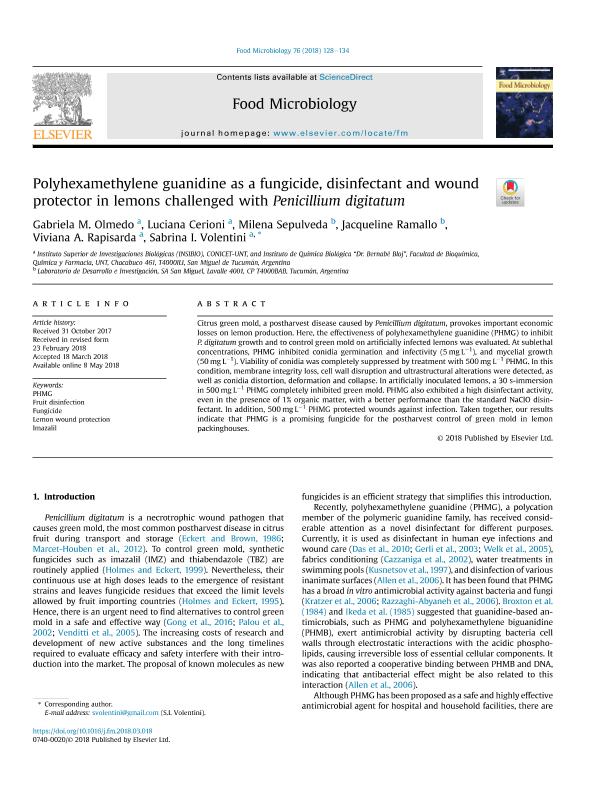Artículo
Polyhexamethylene guanidine as a fungicide, disinfectant and wound protector in lemons challenged with Penicillium digitatum
Olmedo, Gabriela María ; Cerioni, Luciana
; Cerioni, Luciana ; Sepulveda, Milena; Ramallo, Jacqueline; Rapisarda, Viviana Andrea
; Sepulveda, Milena; Ramallo, Jacqueline; Rapisarda, Viviana Andrea ; Volentini, Sabrina Inès
; Volentini, Sabrina Inès
 ; Cerioni, Luciana
; Cerioni, Luciana ; Sepulveda, Milena; Ramallo, Jacqueline; Rapisarda, Viviana Andrea
; Sepulveda, Milena; Ramallo, Jacqueline; Rapisarda, Viviana Andrea ; Volentini, Sabrina Inès
; Volentini, Sabrina Inès
Fecha de publicación:
08/12/2018
Editorial:
Academic Press Ltd - Elsevier Science Ltd
Revista:
Food Microbiology
ISSN:
0740-0020
Idioma:
Inglés
Tipo de recurso:
Artículo publicado
Clasificación temática:
Resumen
Citrus green mold, a postharvest disease caused by Penicillium digitatum, provokes important economic losses on lemon production. Here, the effectiveness of polyhexamethylene guanidine (PHMG) to inhibit P. digitatum growth and to control green mold on artificially infected lemons was evaluated. At sublethal concentrations, PHMG inhibited conidia germination and infectivity (5 mg L−1), and mycelial growth (50 mg L−1). Viability of conidia was completely suppressed by treatment with 500 mg L−1 PHMG. In this condition, membrane integrity loss, cell wall disruption and ultrastructural alterations were detected, as well as conidia distortion, deformation and collapse. In artificially inoculated lemons, a 30 s-immersion in 500 mg L−1 PHMG completely inhibited green mold. PHMG also exhibited a high disinfectant activity, even in the presence of 1% organic matter, with a better performance than the standard NaClO disinfectant. In addition, 500 mg L−1 PHMG protected wounds against infection. Taken together, our results indicate that PHMG is a promising fungicide for the postharvest control of green mold in lemon packinghouses.
Palabras clave:
FRUIT DISINFECTION
,
FUNGICIDE
,
IMAZALIL
,
LEMON WOUND PROTECTION
,
PHMG
Archivos asociados
Licencia
Identificadores
Colecciones
Articulos(CCT - NOA SUR)
Articulos de CTRO.CIENTIFICO TECNOL.CONICET - NOA SUR
Articulos de CTRO.CIENTIFICO TECNOL.CONICET - NOA SUR
Articulos(INSIBIO)
Articulos de INST.SUP.DE INVEST.BIOLOGICAS
Articulos de INST.SUP.DE INVEST.BIOLOGICAS
Citación
Olmedo, Gabriela María; Cerioni, Luciana; Sepulveda, Milena; Ramallo, Jacqueline; Rapisarda, Viviana Andrea; et al.; Polyhexamethylene guanidine as a fungicide, disinfectant and wound protector in lemons challenged with Penicillium digitatum; Academic Press Ltd - Elsevier Science Ltd; Food Microbiology; 76; 8-12-2018; 128-134
Compartir
Altmétricas



